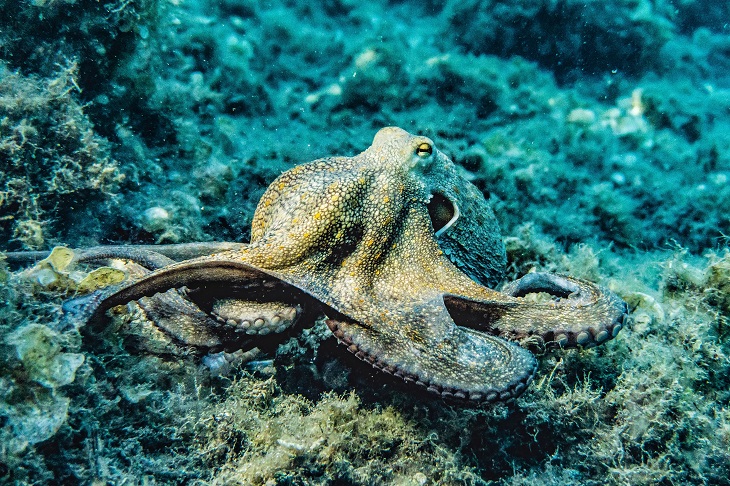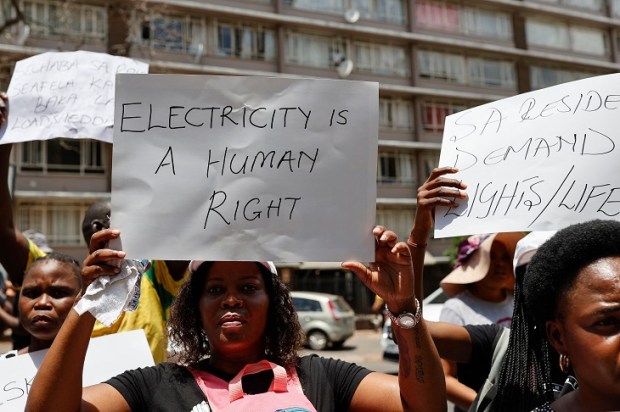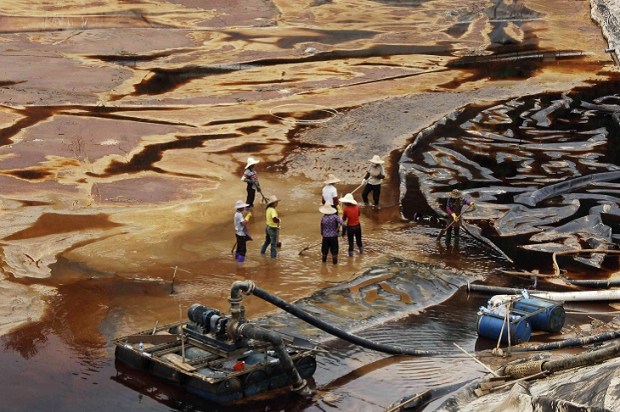It would be a mistake to view the South China Sea dispute between China and Japan as a simple territorial gripe over lines on a water-logged map.
The two nations have long been hostile, and China’s threats last year to ‘nuke it’ if Japan allies itself with Taiwan during a Chinese ‘totally peaceful unification’ attack hasn’t exactly settled the region’s nerves. Neither country can escape their shared geography involving expanses of open water which they rely upon for trade. This has seen many international incidents arise from ships bumping into each other after ‘accidentally’ violating shared spaces.
Today, the problem runs all the way to the seabed.
There is a ‘green-rush’ on rare earths pushed by the so-called ‘climate friendly’ technologies of solar, wind, and battery power that require a menagerie of minerals to harvest ‘free’ energy.
The world’s main motivation for tearing apart the sea floor is the pursuit of electric vehicles. Far from ‘loving the oceans’, the production of ecars is fuelling the exploration and mining of previously protected waters. The damage is estimated to be huge, permanent, and result in the extinction of species.
Still feeling all warm and fuzzy, Teals?
Rare earths are not ‘rare’ as the name suggests, they are ‘diffuse’ meaning that small quantities require enormous amounts of mining and are often difficult to separate from their parent rocks. Ore extraction is a messy business that involves toxic chemicals, scary-looking waste piles, and – uh – smelting with ‘evil’ coal.
Global mining companies have been eager to abide by United Nations regulations against fossil fuel mining because it creates a market crunch, elevating their previously worthless mineral holdings into priceless assets. Some are selling for 600 per cent of their previous value.
Yes, everyone is ‘going green’. Green – as in money.
There is nothing virtuous about a mining company that promotes renewables technology. They have simply decided to increase the value of cheap minerals through market manipulation. By embracing short-lived renewables first, mining companies can flog their entire mineral catalogue. When the world exhausts those and returns to fossil fuels or uranium deposits, they get to sell them too. If mining companies skipped straight to building nuclear plants, the rest of their mineral holdings would be worthless.
China has played an even smarter game. Not only do they profit off their global domination in rare earths resources cornering 95 per cent of the industry, they manufacture and distribute renewables to the West giving Beijing dominance over foreign energy infrastructure. Australia’s energy grid will have a comforting ‘made in China’ sticker on the side. China also put the time, money, and ruthless effort into shifting rare earths mining assets from developing nations into Beijing’s portfolio via its Belt and Road Initiative.
If there were any Roman generals left, they’d be side-eyeing the whole thing muttering, ‘I think it might be a trap.’
How many wars in history were fought over resources? Now imagine there’s an Eden-like frontier of precious metals laying beneath the waves in hotly contested or shared regions…
These minerals tend to be distributed along active volcanic fissures, laying on the sea-bed as polymetallic nodules. The richest of these can be found at the Pacific Ring of Fire tectonic plate boundaries where the movement of the Pacific Plate creates the famous volcanism stretching from New Zealand in the south, up through Indonesia, cutting across Japan, arching along the coast of Russia and Canada before following the West Coast of the Americas all the way down to the bottom of South America. There are similar hot beds beneath India and around the base of Africa.
This has turned the world’s oceans and seas into open-cut mines worth trillions. International waters are thought to contain more value than the combined mineral wealth of Earth’s continents.
Deep sea rare earths mining isn’t much better than the pirate era that accompanied the rush for South American gold. There are rules, but they are loose due to the difficulty of monitoring operations thousands of metres below the surface. If a mining company destroys an ancient relic or sacred site, people scream immediately at the pile of rubble – but who sees the fragile ecosystems and underwater paradises being ripped apart? No one. This makes it an attractive business for mining companies.
Most of the regulation is performed through the ‘autonomous’ United Nations body ISA (International Seabed Authority) based out of Jamaica created under the UN Convention on the Law of the Sea. They are not a protection organisation and do not work to prevent deep sea mining. Instead, they attempt to ‘mitigate its damage’ by surveying locations and handing out licences to mining corporations. They are also meant to protect deep sea biodiversity, particularly for ecosystems that we know very little about.
The current Secretary General, Michael W. Lodge, was previously questioned in the press about a potential conflict of interest with mining operations, which he denies. He also has a biography at the World Economic Forum and is listed as a member who last penned an article in 2014 demonstrating the value of operations, writing:
‘Japanese geologists estimate that a single 2.3 km2 patch of seafloor might contain enough rare earth materials to sustain global demand for a year.’
ISA appears to have no problem handing out plenty of mining licences to China despite the communist nation being recognised as the biggest environmental vandal in the world – especially when it comes to waterways. Most of the contracts are specifically for copper, cobalt, and other minerals found in electric batteries. ISA have stated their support for deep sea mining if it props up the renewables industry which fits with their position as part of the UN’s 2030 Sustainable Agenda.
Not everyone is happy, with marine geologist Sandor Mulsow who was, between 2013-19, head of the Office of Environmental Management and Mineral Resources at ISA, quoted in the La Times saying:
‘The ISA is not fit to regulate any activity in international waters. It is like asking the wolf to take care of the sheep.’
China has made itself a world leader in deep sea rare earths mining, with projects and ships all over the Pacific region.
For those wondering why Beijing was so keen to form a close alliance with the Solomon Islands, it may have something to do with their unexplored zinc, gold, phosphate, lead, and nickel deposits – or maybe it is the oil, gas, and deep sea mining in the parameters laid out in the draft maritime cooperation agreement and the Blue Economy Memorandum of Understanding. The Shortland Basin, Guadalcanal, and Iron Bottom Sound all promise fossil fuels in a startling contradiction to the Solomon’s Islands claims that they chose ‘China’ to help them with Climate Change fears.
The ‘blue economy’ is a polite way of saying, ‘yep, we’re going to rip apart the environmentally fragile ocean floor for profit’. Not only is the sea floor destroyed and its creatures sucked up, but the surrounding area is drowned in a thick layer of silt.
China’s progress in this field was discussed by Liu Feng, secretary general of COMRA (China Ocean Mineral Resource R&D Association), who was interviewed by NewsChina:
‘Since the late 1980s, China started working on exploration contract applications, and it was registered as one of the seven pioneer investors in 1991, which indicated that COMRA was required to offer half of its surveyed area of 300,000km2 […] of valuable seabed mining resource area to the ISA as a reserved area [for ISA enterprises or other developing countries].
‘By 2001, we were able to process one ton of nodules per day and successfully attain metallic elements, including copper cobalt, nickel and manganese.
‘China gained another four additional contracts from the ISA for all three seabed mining resources across the Pacific and Indian oceans [polymetallic nodules found on abyssal plains, polymetallic sulphides at hydrothermal vents, and ferromanganese crusts on seamounts and ridges].’
Returning to the contested waters between Japan and China.
Japan has always been at a serious geopolitical disadvantage. As a densely populated volcanic island chain, it is short on mineral and energy resources. It is a net importer of coal, gas, wood, iron, and copper along with a shrinking allocation of farmland. To compensate, it became a manufacturer of high-end electronics, cars, steel, and military parts.
However, despite the barren surface, the seabed surrounding Japan is ridiculously rich in minerals. The mud alone is guessed to contain 16 million tons of rare-earth oxides or between 500 and 780 years of supply. Although Japan is a small nation by land, they have the 8th largest Exclusive Economic Zone – or 4,470,000km2 of potential mining exploration. There could be an astonishing 40 trillion cubic feet of methane clathrate and 400 billion cubic metres of natural gas. Japanese law is currently being revised to properly regulate what will no doubt be the country’s first mining boom in centuries.
The good news for Japan is that most of their wealth lies in the deep shelf to the east, away from China. The bad news is that the Sea of Japan contains petroleum, natural gas, and magnetite. The worse news is that the extremely rich mining area off Okinawa is well and truly within China’s greedy field of vision.
Does this destroy the fragile ecosystems at the bottom of the ocean? Absolutely. As David Santillo, a Greenpeace research fellow, said:
‘In all cases, seabed mining will, by its very nature, destroy species and habitats within the mining zones. There is no justification for a ‘gold rush’ to mine the seabed; instead we should be focusing on making smarter and more efficient use of the materials we already have.’
Despite everyone’s pledges to ‘climate change’, the pursuit of Net Zero policies and ‘ethical cars’ has sparked a mining rush that threatens the Earth’s most important but least understood ecosystem. Nations desperate to secure their share of rare earths might even spark a catastrophic global conflict.
The hunt for rare earths is all set to finally tip geopolitics off the deep end.
Alexandra Marshall is an independent writer. If you would like to support her work, shout her a coffee over at donor-box.
Got something to add? Join the discussion and comment below.
Get 10 issues for just $10
Subscribe to The Spectator Australia today for the next 10 magazine issues, plus full online access, for just $10.

























Comments
Don't miss out
Join the conversation with other Spectator Australia readers. Subscribe to leave a comment.
SUBSCRIBEAlready a subscriber? Log in